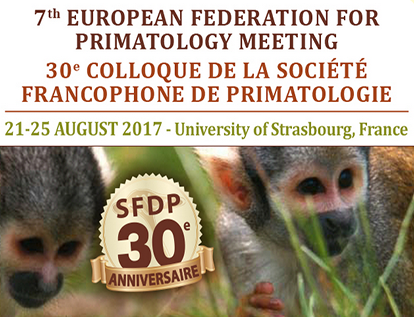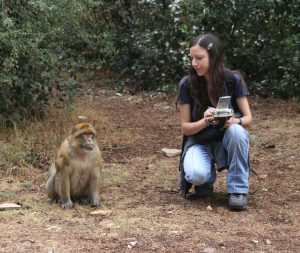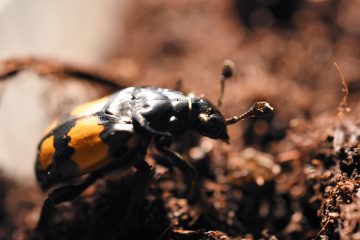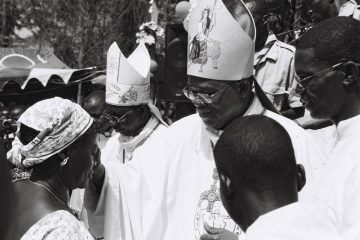
Sandra MOLESTI,
Former Fyssen 2015
7th European Federation for Primatology (EFP) Meeting
30e colloque de la société francophone de primatologie
21-25 aout 2017 – Université de Strasbourg, France
Sandra Molesti (a,c), Adrien Meguerditchian (b,c), Marie Bourjade (a,c)
(a) Laboratoire CLLE – LTC, UMR 5263, Université Toulouse Jean-Jaurès, Toulouse, France; (b) Laboratoire de Psychologie Cognitive, UMR 7290, Université Aix-Marseille, Marseille, France; (c) Station de Primatologie, UPS 846, Centre National de la Recherche Scientifique, Rousset, France
Given their close phylogenetic proximity with humans, non-human primates can be used as models to investigate the evolution of advanced communicative systems. In this regard, there is renewed interest in studies concerning gestural communication. In apes, it has been shown that the production of gestures is intentional (e.g. the gestures are adjusted to the attentional state of the recipient), flexible (e.g. the same gesture can be used in several contexts), and variable across individuals and populations. However, compared to apes the gestural communication of monkeys has been understudied. It is thus important to establish which gestures are used by monkeys and to investigate whether their gestural system possesses the same properties as the gestural system found in apes. In this study, we investigated the gestural communication of 47 captive olive baboons of all ages living in three social groups. We used a focal sampling approach to observe each subject for a total of 5 h spread over one year. For each signal produced by the focal subject toward a recipient we recorded its physical description, the orientation of the signaller, the attentional state of the recipient, the situational context and the response of the recipient. We collected a total of 2 820 focal sessions, corresponding to 60 sessions of 5 min for each subject, and established a preliminary list of 65 signals produced by the baboons. Preliminary results indicate that 91% of the signals were produced when the signaller was looking at the recipient, and 85% when the recipient was attending. The data will be further analysed to investigate in detail the properties of the signals, notably in terms of intentionality, flexibility and variability. This study represents the first systematic investigation of the gestural communicative system of olive baboons and the results will be compared to the gestural system described in apes.
Sandra Molesti est une éthologue qui a soutenu sa thèse en 2014 à l’Université de Lincoln (Angleterre) sur les interactions de toilettage et la coopération chez le macaque de Barbarie sauvage au Maroc. Elle est actuellement post-doctorante de la Fondation Fyssen et rattachée à l’Université Toulouse Jean-Jaurès (Laboratoire CLLE-LTC, axe Cognition, Communication et Développement) où elle travaille sur la communication et la coopération chez le babouin olive. Les résultats de son projet participeront à l’avancée des recherches sur l’évolution du langage et de la coopération, en examinant les continuités et discontinuités entre les humains et nos plus proches cousins.
Publications
. Animal Cognition, , Volume 19, Issue 1, pp 133–146
Cooperation in wild Barbary macaques: factors affecting free partner choice
. American Journal of Primatology, 9 June 2017
Evidence of direct reciprocity, but not of indirect and generalized reciprocity, in the grooming exchanges of wild Barbary macaques (Macaca sylvanus)


